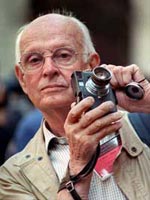| (insert your NIE or newspaper logo here) |
Weekly Online LessonOnline Lesson ArchiveGrade Level: 6-8
|
The Art of Black and White Photography
 On Tuesday, August 3, 2004, Henri Cartier-Bresson, died in his home in the south of France at the age of 95.
On Tuesday, August 3, 2004, Henri Cartier-Bresson, died in his home in the south of France at the age of 95.
Although his name may not be recognized by everyone, many people regard him as the father of photojournalism.
Using a 35mm camera, he shot his subjects exclusively with black and white film. During his career -- which spanned three decades -- Cartier-Bresson traveled to China, India, Indonesia, Egypt, Cuba and the Soviet Union, capturing what he called "decisive moments."
But Cartier-Bresson did not simply "point and shoot" his camera to capture news events. Many agree that his photographs were also works of art.
During this week's lesson, you're going to meet a number of black and white photographers. As you review and analyze their works, you'll compare their creative styles.
The Artist's Eye
 Like all great artists, photographers have learned art's basics and blend that understanding with their personal creativity.
Like all great artists, photographers have learned art's basics and blend that understanding with their personal creativity.
Photographers who use black and white film, rather than color, are especially reliant on the fundamentals of composition, contrast, light, and shadow.
Let's begin our tour at the Minneapolis Institute of Arts, where they will help you Get the Picture.
Here, you will meet six artists and learn about their special blends of black and white photography. (The seventh featured artist, Stephanie Torbert, uses color film.)
Once in a gallery, click Next to move through the pages. As you browse, click on any buttons labeled "Context," "Comparison," "Diagram," etc.
Read about the featured artists, and think about how they view photography and the world they photograph:
How have the various artists used the art and science of photography, including any special effects? In what ways do the photographers differ in their creative approaches? How exactly did these artists blend reality and art?
What seems to inspire each of these photographers? What skills, personal experience, and other assets do the artists use?
The Expanded Gallery Tour
 Now take a look at the work of more black and white photographers, by first visiting the Masterworks of Photography gallery at The American Museum of Photography. These photographs are considered more art than news and were taken from 1840 to 1975.
Now take a look at the work of more black and white photographers, by first visiting the Masterworks of Photography gallery at The American Museum of Photography. These photographs are considered more art than news and were taken from 1840 to 1975.
Compare the subjects and styles of those artists with a few of the Newseum's Photojournalists of the Month.
Review the photos of at least a few of these news photographers:
In what ways is photojournalism similar to art photography? In what ways are they different?
Do you like one or two photographers better than the work of others? If so, what is it about how or what they photograph that you like?
What aspects -- shapes, composition, shading, etc. -- do you notice about each photograph first? How do you think these photographs would look and feel differently if they had been taken in color instead of black and white?
Newspaper Activities
Find all of the black and white photos taken by Targetnewspaper newspaper's staff and group them by photographer. Do you notice distinctive styles of each photographer? If so, can you describe what aspects make their photographs different from another photographer? If a staff photographer also has one or more color photos in the paper, also look at those. Is his or her color work shot in a similar or different way to the black and white? Make black photocopies of the color photos -- do you look a the photo differently in color vs. black and white?
© Copyright 2004
Learners
Online,
Inc.
